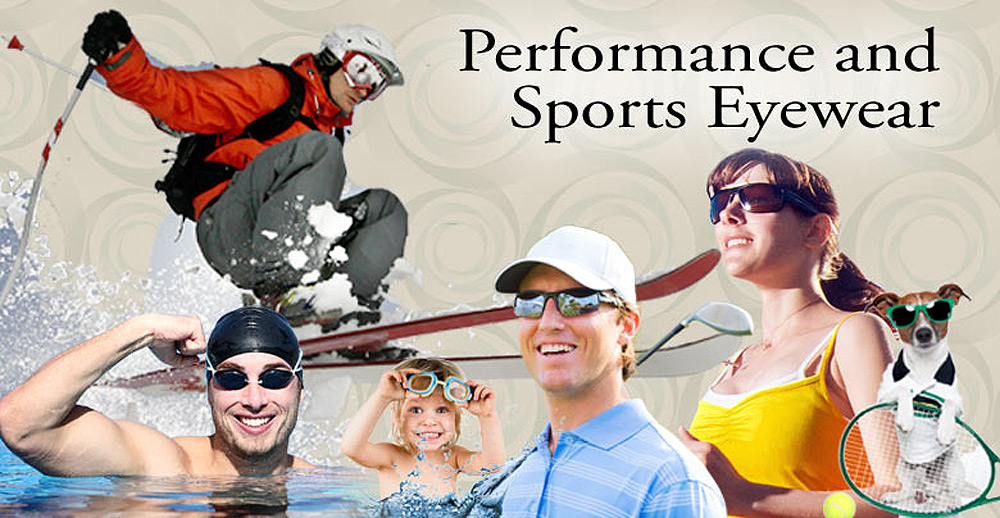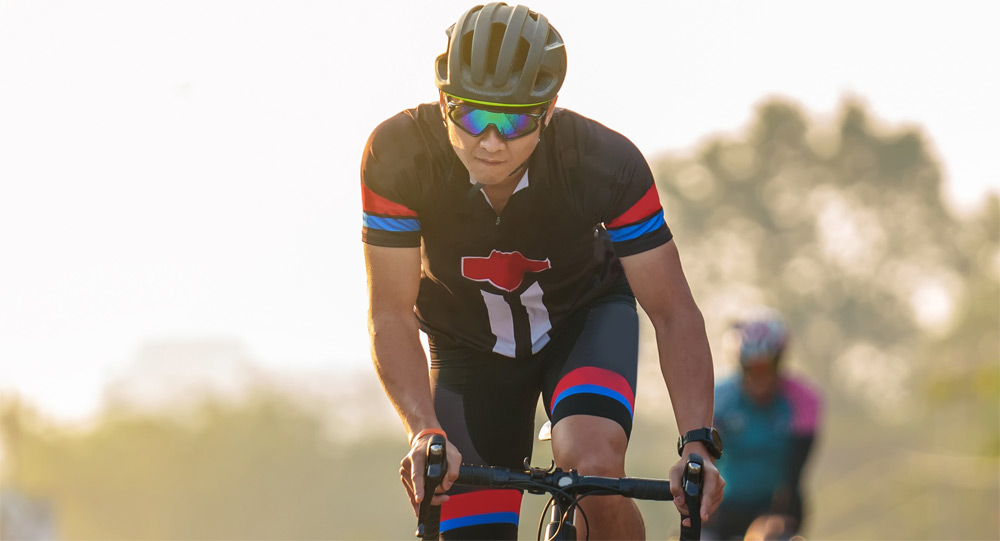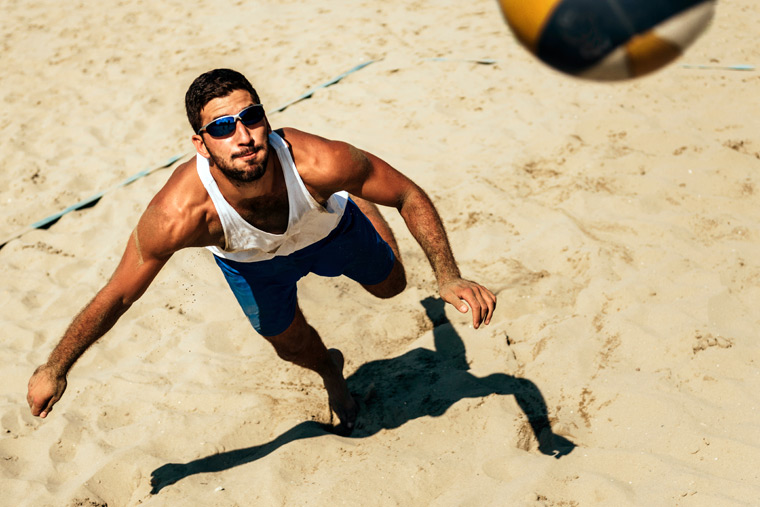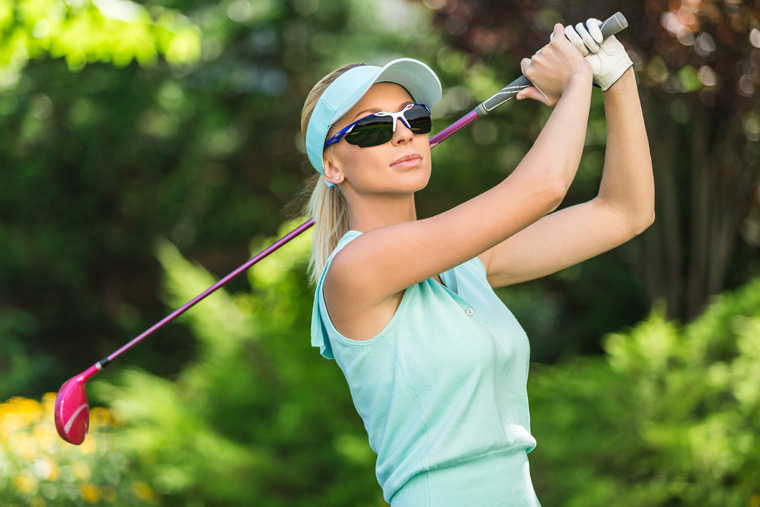
If there's one thing that seems to be a key to success in sports, it's vision. But did you know you can improve your performance by improving some aspects of your vision? It's easy to recognize problems, and even easier to solve them. The following are some aspects of vision which can be the difference between victory and defeat, and some exercises to improve performance.
The most important thing when purchasing sports eyewear is selecting the
right material for both the lenses and the frames. Injuries when playing
sports can cause severe injury to the eye, but sports eyewear can help.
Although the type of sport determines which eyewear is best for you, the
basic principles are the same.
Sports Specific Lenses

For athletes and sports applications, we highly recommend the Polycarbonate Lenses. Polycarbonate is virtually unbreakable, and it is used exclusively by many of the world's finest sports and specialty glasses manufacturers and optical laboratories. It is thinner, lighter, and stronger than glass.
What's more, polycarbonate lenses can survive a 12-gauge shotgun blast from 10 yards away. Polycarbonate naturally blocks almost all of the sun's harmful UV rays. No coatings are required to block UV rays on a polycarbonate lens. The strength of polycarbonate is partially derived from its flexibility. It is not brittle and will not shatter. This strength also contributes to its main weakness.
Because polycarbonate is so flexible, it is also easily scratched. New lens coatings and hardeners have significantly improved polycarbonate's durability, but choosing a polycarbonate lens still requires an informed consumer. Quality lens treatments match the refractive index of the lens material and allow light to pass through the coating at the same speed as the lens. If light passes through the lens coating and the lens at two different speeds, vision will be blurred.
Every lens we offer is manufactured to improve vision. Our
patients are never at risk of getting stuck with substandard lenses or coatings. We look forward to discuss your lens options with you.
Sports Specific Eyewear - Sunglasses
Choosing sunglasses for the sports you participate in can give you a leg up over the competition. Not all sunglasses are alike. New technology gives you options that offer protection for your eyes, and a tool to enhance your visual abilities. Improving your visual abilities through proper sports and specialty sunglasses can help substantially improve your performance with little effort on your part.
The Power of Lens Tint
Sports and specialty eyewear is able to hone in on the objects you want and need to see best by filtering the color and contrasts that bring you visual acuity.
For athletes that need 100 percent color accuracy, a neutral gray tint provides this. But, for most athletes, enhancing contrasts will help bring out the object of play best.
Viewing a ball against the sky, an object in the water, moguls on a slope, a tennis ball flying over a net are seen better with contrast. Brown and copper-colored tints often offer the best visual enhancements than other tints.
Knowing how to choose the right tint, the right lens and style for what you are doing requires someone who knows your eyes, your goals and the products. We will work with you to give you tools for athletic success
Sports Specific Eyewear - Frames
Your eyewear should be as durable and lightweight as possible with a snug, but comfortable, fit. Your glasses should be close enough to your eyes that no stray light gets through - at the same time, your eyelashes should not touch the lenses. The material should not splinter and be as durable as possible while still remaining malleable and flexible. These properties reduce the risk of injury, i.e. when falling, because your eyewear 'gives way' instead of breaking.
Choosing the right material also significantly affects wearer comfort. Here's a rule of thumb: the lighter the eyewear is, the more comfortable it sits on your nose. For this reason, and because it reduces the risk of injury, eyewear made of plastic (such as polycarbonate and polyamide) should be your first choice.
Under most circumstances, at least 90% of sports-related eye injuries are preventable with the proper use of protective sports eyewear. That is why the American Academy of Pediatrics and American Optometric Association both strongly recommend protective eyewear for all participants in sports in which there is a risk of eye injury.
Please do not engage in sports
without proper equipment.
Call for a Sports Specific Eyewear Consultation.
DYNAMIC VISUAL ACUITY
Dynamic visual acuity is your ability to see objects when they are moving fast. This is important in sports like hockey, racquetball, and tennis. To improve dynamic visual acuity, cut out letters, stick them to a record turntable, and try to identify the letters at different speeds.
VISUAL CONCENTRATION
Visual concentration is your ability to ignore distractions happening around you. Your eyes naturally react to movement in the field of vision from spectators, other participants or the playing environment. To improve your visual concentration, have a friend stand nearby and wave their hands erratically while you practice.
EYE TRACKING
Eye tracking is following an object with your eyes without much head motion. It is important with any sport that involves a fast-moving ball. Good eye tracking will improve balance and reaction time. You can improve your eye tracking by watching the flight of a ball while keeping a book balanced on your head.
EYE-HAND-BODY COORDINATION
Eye-hand-body coordination is how your muscles and limbs react to the information gathered by your eyes. It affects timing and body control. To improve your eye-hand-body coordination, jump up and down on an old mattress while a friend tosses you a tennis ball from a variety of angles. Catch the ball and toss it back
VISUAL MEMORY
VVisual memory is the ability to process and remember a fast moving, complex picture of people and things. It is very important in basketball, hockey, and soccer, where the game quickly moves up the field. Visual memory helps you know where your teammates and opponents are positioned. To improve visual memory, look at a magazine page for a second, then turn the page. Try to reconstruct the images you just saw. When you have mastered the exercise, allow 5 seconds between seeing the image and reconstructing it.
PERIPHERAL VISION
Peripheral vision is the ability to see what is not directly in front of you, out of the corner of your eye. This allows you to see your teammate to your left or right while focusing on the goal in front of you. To make your peripheral vision more useful, try watching television with your head turned to one side or the other.
VISUAL REACTION TIME
Visual reaction time is what allows a batter to hit the ball or a tennis player to return a serve. It is the speed with which your brain interprets and reacts. To improve your visual reaction time, stand with your back to a friend. Have them toss a ball to you and yell, "Now!" When you hear the yell, turn around and try to catch the ball. By repeating this exercise, you can teach your brain to react more quickly.
FOCUS FLEXIBILITY
Focus flexibility allows a quarterback to quickly focus on his receivers even though they are at varying distances. To improve focus flexibility, post a magazine page on a wall about 15 feet away at eye level in front of you. Hold a similar page in your hand out in front of you, so that it is slightly to one side of your view of the page on the wall. Focus on an object or words on the page on the wall. Then quickly switch focus to the page in your hand. By switching focus back and forth, you will improve your focus flexibility.
DEPTH PERCEPTIONG
Depth perception lets you judge distance. This is important in basketball, golf, and other sports involving distance to the goal. To improve depth perception, have a friend point a straw at you, parallel to the ground, with the straw about two feet away from you. Practice quickly inserting a toothpick into the straw..
